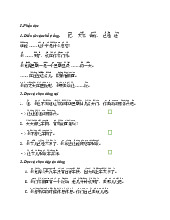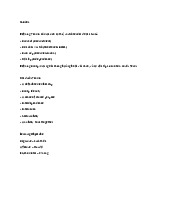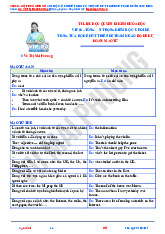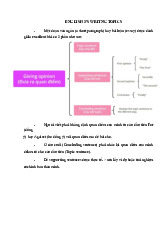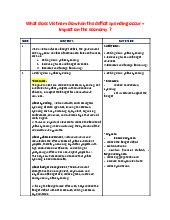




Preview text:
lOMoARcPSD|50582371
NHÓM 6 KỲ THI TỐT NGHIỆP TRUNG HỌC PHỔ THÔNG NĂM 2022 (Đ thi có 05 trangề )
Bài thi: NGOẠ ỮI NG , Môn thi: TIẾNG ANH
Th i gian làm bài: 60 phút, không k th i gian phát đờ ể ờ ề
H , tên thí sinh:ọ ………………………………………. Số báo
danh: ……………………………………….
Mark the le*er A, B, C, or D on your answer sheet to indicate the word whose underlined part differs
from that of the other three in pronuncia=on in each of the following ques=ons.
QuesTon 1. A. permi)ed
B. wanted C. D. needed stopped QuesTon 2. A. meat
B. bean D. meaning C. sweat
Mark the le*er A, B, C, or D on your answer sheet to indicate the word that differs from the other
three in the posi=on of primary stress in each of the following ques=ons. QuesTon 3. A. relax B. enter C. behave D. allow
QuesTon 4. A. dominate B. disagree C. entertain D. interfere
Mark the le*er A, B, C, or D on your answer sheet to indicate the correct answer to each of the
following ques=ons.
QuesTon 5. Your mother is cooking in the kitchen, _______? A. won't she B. didn’t she C. doesn't she D. isn't she
QuesTon 6. Over 100 guests _______ to a)end John’s birthday at home. A. invited B. were inviFng C. were invited D. invite
QuesTon 7. I have something to do so let’s meet …. 8p.m. A. of B. at C. in D. on
QuesTon 8. The higher we climbed, _______ difficult it was to breathe. A. more
B. most ofD. most C. the more
QuesTon 9. My mother gave me a (n) _______ bike on my 17th birthday.
A. red expensive Japanese
B. Japanese red expensive
C. expensive red Japanese
D. expensive Japanese red QuesTon
10. When the boss walked into the office, his secretary ________.
A. types C. is typing B. was typing D. has typed
QuesTon 11. She got the job she had very li)le experience. A. although B. because of C. despite D. because
QuesTon 12. _______, I wil give him the report.
A. When he had returned B. When he returns C. When he returned
D. When he was returning
QuesTon 13. her handwriFng report, she watched her favorite movie. A. Having finished
B. Have finished C. Have been finishing D. Have been finished
QuesTon 14. We wil ______ our English vocabulary if we read English books every day. A. rich B. richness C. enrich D. richly
QuesTon 15. I was late for work because my alarm clock did not _______ . A. turn off B. put off C. send off D. go off
QuesTon 16. Peter______ a be)er understanding of Algebra than we do. A. B. has m akes C. takes D. gives
QuesTon 17. The sight of his pale face brought ________ to me how il he really was. A. place B. house C. life D. home lOMoARcPSD|50582371
QuesTon 18. David wants to have a part-Fme _______to pay for his tuiFon fee.
A. career B. profession C. work D. job
QuesTon 19. In the formal interview, it is essenFal to maintain good eye with the interviewers. A. contact B.
touch C. link D. connecFon
Mark the le*er A, B, C, or D on your answer sheet to indicate the word(s) CLOSEST in meaning to the
underlined word(s) in each of the following ques=ons.
QuesTon 20. The washing machine I have just bought is very simple to use. A. boring
B. interesFngD. difficult C. easy
QuesTon 21. The new col ege is intended to improve the life chances of children in the inner city. A. producFons
B. communiFesD. quesFons C. opportuniFes
Mark the le*er A, B, C, or D on your answer sheet to indicate the word(s) OPPOSITE in meaning to the
underlined word(s) in each of the following ques=ons.
QuesTon 22. Children brought up in a caring environment tend to grow more sympatheFc towards others. A. loving B. dishonest C. healthy D. hateful
QuesTon 23. It’s quite disappoinFng that some people sFl turn a blind eye to acts of injusFce they witness in the street. A. take no noFce of
B. have no feeling for C. show respect for D. pay a)enFon to
Mark the le*er A, B, C, or D on your answer sheet to indicate the op=on that best completes each of
the following exchanges.
QuesTon 24. Janet wants to invite Susan to go to the cinema
- Janet: “Do you feel like going to the cinema this evening?” - Susan: “______.”
A. I don’t agree, I’m afraid B. You’re welcome C. That would be great D. I feel very bored
QuesTon 25. Baker: “In my opinion, women o`en drive more careful y than men.” - Barbara: “______.” A. Never mind
B. What nonsense D. C. Absolutely Yes, please
Read the following passage and mark the le*er A, B, C, or D on your answer sheet to indicate the
correct word or phrase that best fits each of the numbered blanks from 26 to 30.
Earthquakes are amongst the most destrucFve natural disasters. They usually strike without any warning
and result in a great loss of life and an enormous demoliFon of buildings. AddiFonally, they may cause
devastaFng landslides or create giganFc Fdal waves (26)__________, in fact, are col osal walls of water
smashing into seashores with such force that they are (2 7 )__________of destroying coastal ciFes.
( 28)______, the vast majority of fataliFes and serious injuries come about when buildings col apse. Most
frequently, the earthquake lasts 30 to 60 seconds, so usually there is no Fme to (29)______ the mortal
upshot once the shaking starts. The savage forces of an earthquake trigger off a complex chain reacFon in
the building's structure when it is shaken, li`ed, pushed or pul ed. A building's height, its shape and
(30)_______factors such as construcFon materials are the most significant factors deciding about the
survival or col apse of the structure and, consequently, about the life or death of its inhabitants.
QuesTon 26. A. When B. which C. where D. who QuesTon 27. A. potenFal
B. conceivable C. capable
D. possible QuesTon 28. B. Therefore
A. However C. Moreover D. Otherwise
QuesTon 29. A. avert B. evade C. abstain D. restrain QuesTon 30.
A. anotherB. other C. every D. one lOMoARcPSD|50582371
Read the following passage and mark the le*er A, B, C, or D on your answer sheet to indicate the
correct answer to each of the ques=ons from 31 to 35.
Zoo officials say that they are concerned about animals. However, most zoos remain "col ecFons" of
interesFng "items" rather than protecFve habitats. Zoos teach people that it is acceptable to keep animals
in capFvity. However, animals in zoos are bored, limited, lonely, and far from their natural homes.
Zoos claim to educate people, but in fact, visitors don't learn anything meaningful about the natural
behavior, intel igence, or beauty of animals. Most zoo areas are quite small, and visitors can rarely observe
animals’ normal behavior in these unnatural spaces.
The animals are kept together in small spaces, with no privacy and li)le opportunity for mental
sFmulaFon or physical exercise. This results in abnormal and self-destrucFve behavior called zoochosis.
A worldwide study of zoos found that zoochosis is common among animals in small spaces or cages. For
example, Bears spend 30 percent of their Fme walking back and forth. These are all signs of distress.
Zoos also claim to save animals from exFncFon. However, zoos that breed endangered animals, such
as big cats and Asian elephants, o`en do not release them to the wild. UlFmately, we wil save endangered
species only if we save their habitats. We also need to stop people from kil ing them. Instead of supporFng
zoos, we should support groups that work to protect animals and preserve their homes in the wild.
(Adapted from www.usingenglish.com/forum/threads/zoo)
QuesTon 31. What is the passage mainly about?
A. The natural homes for zoos’ animals.
B. The suffering zoos bring captured animals.
C. The things zoo officials concern.
D. The comfort for zoo visitors. QuesTon 32. The word
“observe” in paragraph 2 is closest in meaning to ______. A. watch B. feed C. raise D. touch
QuesTon 33. According to the passage, zoochosis is popular among animals in ______. A. the wild B. natural homes C. cages D. large spaces
QuesTon 34. The word “them” in paragraph 4 refers to ______.
A. signs B. their habitats
C. endangered animals D. zoos
QuesTon 35. Which of the fol owing is TRUE according to the passage? A. Zoos
educate people by showing them animals’ natural behavior.
B. Zoos remain animals’ protecFve habitats.
C. Zoos always release endangered animals to the wild.
D. Zoos keep animals in small spaces
Read the following passage and mark the le*er A, B, C, or D on your answer sheet to indicate the
correct answer to each of the ques=ons from 36 to 42.
Australians place a high value on independence and personal choice. This means that a teacher or
course tutor wil not tel students what to do, but wil give them a number of opFons and suggest they
work out which one is the best in their circumstances. It also means that they are expected to take acFon
if something goes wrong and seek out resources and support for themselves.
Australians are also prepared to accept a range of opinions rather than believing there is one truth.
This means that in an educaFonal semng, students wil be expected to form their own opinions and defend
the reasons for that point of view and the evidence for it.
Australians are uncomfortable with differences in status and hence idealise the idea of treaFng
everyone equally. An il ustraFon of this is that most adult Australians call each other by their first names.
This concern with equality means that Australians are uncomfortable taking anything too seriously and
are even ready to joke about themselves. lOMoARcPSD|50582371
Australians believe that life should have a balance between work and leisure Fme. As a consequence,
some students may be criTcal of others who they perceive as doing nothing but study.
Australian noFons of privacy mean that areas such as financial ma)ers, appearance and relaFonships
are only discussed with close friends. While people may volunteer such informaFon, they may resent
someone actually asking them unless the friendship is firmly established. Even then, it is considered very
impolite to ask someone what they earn. With older people, it is also rude to ask how old they are, why
they are not married or why they do not have children. It is also impolite to ask people how much they
have paid for something, unless there is a very good reason for asking.
(Adapted from Complete Ielts student book by Guy Brook Hart and Vanessa Jakeman)
QuesTon 36: Which best serves as the Ftle for the passage?
A. The story about Australia B. Australian culture
C. Australian culture shock
D. What should we do when we come to Australia?
QuesTon 37: The word “them” in paragraph 1 refers to _______. A. Australians B. circumstances C. students D. opFons
QuesTon 38: The word “status” in paragraph 3 is closest in meaning to _______.
A. posiFon B. marriage C. qualificaFon D. job
QuesTon 39: In paragraph 3, most adult Australians call each other by their first names because A.
Australians are difficult to remember people’s surnames.
B. Australians get on wel with each other.
C. Calling each other by their first names make them more friendly.
D. Australians restrict class discriminaFon.
QuesTon 40: The word “criTcal” in paragraph 4 is closest in meaning to _______ A. faulninding
B. complimentary C. grateful D. appreciaFve
QuesTon 41: Which of the fol owing is NOT true, according to the passage? A. A
teacher or course tutor wil not tel students what to do.
B. Australians are always prepared to believe that there is one truth.
C. Australians are also prepared to accept a range of opinions.
D. Students in Australia wil be expected to form their own opinions.
QuesTon 42: Which of the fol owing can be inferred from paragraph 5? A. It is
polite when Australians ask each other about their salary.
B. It is unacceptable to discuss financial issues with people you do not know wel .
C. Australians o`en ask each other their ages and tel each other about children.
D. It is wise to ask how old they are.
Mark the le*er A, B, C, or D on your answer sheet to indicate the sentence that best combines each
pair of sentences in the following ques=ons
QuesTon 43. Marie didn’t turn up at John’s birthday party. I feel so sorry for that. A. If
only Marie turn up at John’s birthday party.
B. I wish Marie had turned up at Johns birthday party.
C. I wished Marie wouldn’t turn up at John’s birthday party.
D. It’s a shame Marie had turned up at John’s birthday party.
QuesTon 44. Lan had some shocking words on her facebook. Then, everyone knew her. A.
Hardly when Lan had some shocking words on her facebook everyone knew her.
B. Only a`er Lan had some shocking words on her facebook everyone knew her.
C. Only when Lan had some shocking words on her facebook did everyone know her.
D. UnFl Lan had some shocking words on her facebook did everyone knew her. lOMoARcPSD|50582371
Mark the le*er A, B, C, or D on your answer sheet to indicate the underlined part that needs correc=on
in each of the following ques=ons.
QuesTon 45. There used to be a movie theater here, but it closes a long Fme ago. A B C D
QuesTon 46. Semng a fixed contribuFon makes it easy for students to know what is expected of A B C him. D
QuesTon 47. The company had be)er develop more rapid and reliant systems for handling A B C customers' complaints. D
Mark the le*er A, B, C, or D on your answer sheet to indicate the sentence that is closest in meaning to
each of the following ques=ons
QuesTon 48. She began to play the piano three years
ago. A. She has played the piano since three years.
B. She has played the piano for three years
C. She doesn’t play the piano now.
D. She stops playing the piano now.
QuesTon 49. "I'l tel you about this tomorrow, Daisy." said Peter.
A. Peter said to Daisy that he wil tel her about that the next day.
B. Peter told Daisy that I would tel you about that the next day.
C. Peter told Daisy that he would tel her about that the next day.
D. Peter told Daisy that she would tel you about that the next day.
QuesTon 50. It’s very likely that the company wil accept his applicaFon. A. The
company needs accept his applicaFon.
B. The company might accept his applicaFon.
C. The company must accept his applicaFon.
D. The company should accept his applicaFon.
----------HẾT----------
